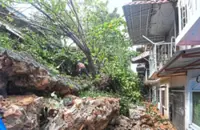Search and rescue efforts are ongoing for Vijayalaksmi who fell into this sinkhole in Jalan Masjid India. — Filepic
KUALA Lumpur City Hall (DBKL) should establish a comprehensive underground mapping system for city infrastructure and utilities, if it does not already have one, says Institution of Engineers Malaysia (IEM).
IEM president Prof Dr Jeffrey Chiang Choong Luin said the recent sinkhole that swallowed 48-year-old Indian national Vijayalaksmi in Jalan Masjid India highlighted urgent need for action.
“This is an opportunity for DBKL to leverage technology and map out the city’s intricate underground infrastructure.
“With the right resources and determination, future disasters can be prevented,” he told StarMetro.
“Furthermore, IEM is willing to assist in this crucial endeavour, should City Hall be open to collaboration,” he added.
IEM, which has over 50,000 members, had earlier issued a statement regarding the Jalan Masjid India sinkhole incident, urging the authorities to conduct a thorough investigation and offering its expertise to support the effort.
The organisation called for more stringent safety checks by qualified professional engineers in the design, construction and supervision of critical infrastructure to prevent a recurrence.
In 2020, StarMetro reported that then Kuala Lumpur mayor Datuk Seri Nor Hisham Ahmad Dahlan had ordered an inter-agency study with utility companies to map out the extensive network of underground cables and pipes in the capital city, prompted by the increasing number of sinkholes.
In the exclusive interview, Nor Hisham had also revealed then that while DBKL had developed a basic framework for addressing such issues, significant challenges remained due to ageing infrastructure, some of which were over 50 years old.
In a recent interview with StarMetro, the former mayor stressed the need for comprehensive underground mapping for Kuala Lumpur as well as good collaboration between agencies.
During his tenure, Nor Hisham said he had difficulties obtaining accurate underground mapping due to lack of cooperation from utility companies.
“One of the significant challenges we faced was getting utility companies on board with the mapping process.
“Many were reluctant to share their data, which made it difficult to create a comprehensive and reliable map of the underground infrastructure,” he said.
Nor Hisham also believed that DBKL’s current data might not be accurate as records could be outdated and unreliable.
This, he said, could lead to unforeseen delays in construction projects and pose hazards for road users and contractors.
He cited examples of past projects that were delayed, such as the Bulatan Dato Onn beautification and Jalan Bangsar flood mitigation projects that faced lengthy setbacks due to unexpected underground infrastructure.
The Aug 23 Jalan Masjid India sinkhole incident has heightened concerns among the area’s residents and businesses.
The search and rescue effort for the Indian tourist is ongoing.






